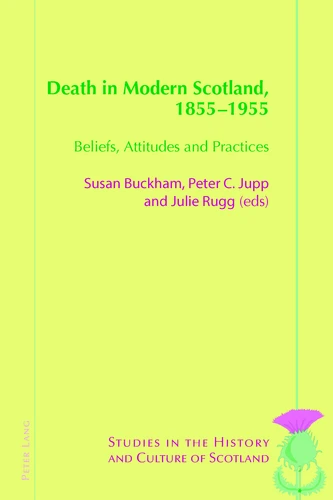Death in Modern Scotland, 1855–1955. Beliefs, Attitudes and Practices
Par : , ,Formats :
- Paiement en ligne :
- Livraison à domicile ou en point Mondial Relay entre le 8 août et le 23 aoûtCet article sera commandé chez un fournisseur et vous sera expédié 2 à 4 semaines après la date de votre commande.
- Retrait Click and Collect en magasin gratuit
- Livraison à domicile ou en point Mondial Relay entre le 8 août et le 23 août
- Nombre de pages336
- ISBN978-3-0343-1821-1
- EAN9783034318211
- Date de parution01/03/2016
- CollectionStudies in the History and Cul
- ÉditeurPeter Lang
Résumé
The period 1855 to 1955 was pivotal for modern Scottish death culture. Within art and literature death was a familiar companion, with its imagined presence charting the fears and expectations behind the public face of mortality. Framing new concepts of the afterlife became a task for both theologians and literary figures, both before and after the Great War. At the same time, medical and legal developments began to shift mortality into the realms of regulation and control.
This interdisciplinary collection draws from the fields of art, literature, social history, religion, demography, legal history and architectural and landscape history. The essays employ a range of methodologies and materials – visual, statistical, archival and literary – to illustrate the richness of the primary sources for studying death in Scotland. They highlight a number of intersecting themes, including spirituality and the afterlife, the impact of war, materiality and the disposal of the body, providing new perspectives on how attitudes towards death have affected human behaviour on both personal and public levels, and throwing into relief some of the unique features of Scottish society.
This interdisciplinary collection draws from the fields of art, literature, social history, religion, demography, legal history and architectural and landscape history. The essays employ a range of methodologies and materials – visual, statistical, archival and literary – to illustrate the richness of the primary sources for studying death in Scotland. They highlight a number of intersecting themes, including spirituality and the afterlife, the impact of war, materiality and the disposal of the body, providing new perspectives on how attitudes towards death have affected human behaviour on both personal and public levels, and throwing into relief some of the unique features of Scottish society.
The period 1855 to 1955 was pivotal for modern Scottish death culture. Within art and literature death was a familiar companion, with its imagined presence charting the fears and expectations behind the public face of mortality. Framing new concepts of the afterlife became a task for both theologians and literary figures, both before and after the Great War. At the same time, medical and legal developments began to shift mortality into the realms of regulation and control.
This interdisciplinary collection draws from the fields of art, literature, social history, religion, demography, legal history and architectural and landscape history. The essays employ a range of methodologies and materials – visual, statistical, archival and literary – to illustrate the richness of the primary sources for studying death in Scotland. They highlight a number of intersecting themes, including spirituality and the afterlife, the impact of war, materiality and the disposal of the body, providing new perspectives on how attitudes towards death have affected human behaviour on both personal and public levels, and throwing into relief some of the unique features of Scottish society.
This interdisciplinary collection draws from the fields of art, literature, social history, religion, demography, legal history and architectural and landscape history. The essays employ a range of methodologies and materials – visual, statistical, archival and literary – to illustrate the richness of the primary sources for studying death in Scotland. They highlight a number of intersecting themes, including spirituality and the afterlife, the impact of war, materiality and the disposal of the body, providing new perspectives on how attitudes towards death have affected human behaviour on both personal and public levels, and throwing into relief some of the unique features of Scottish society.

